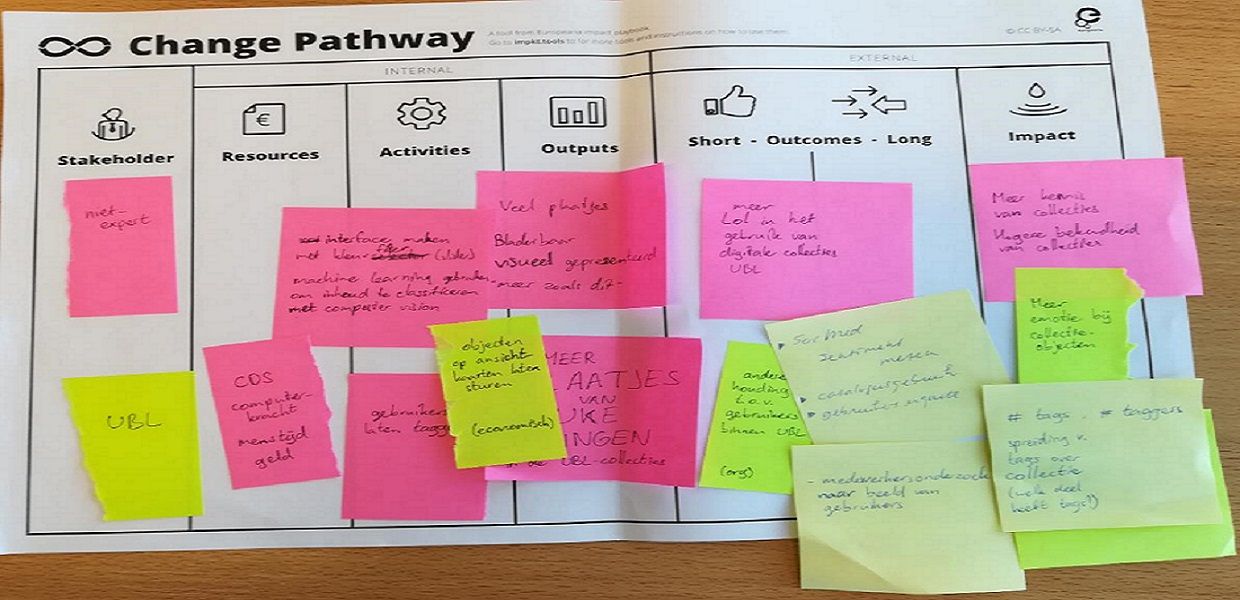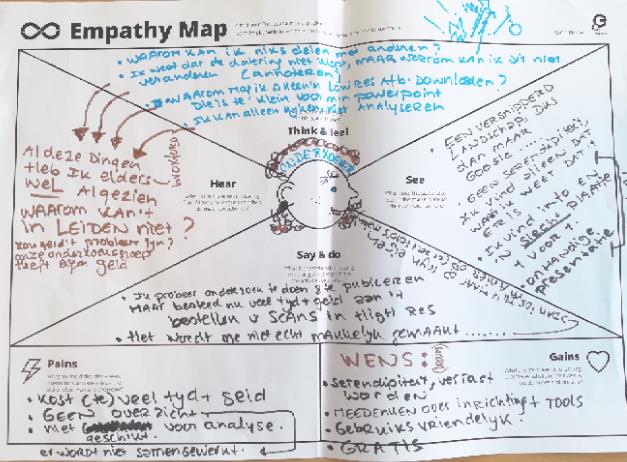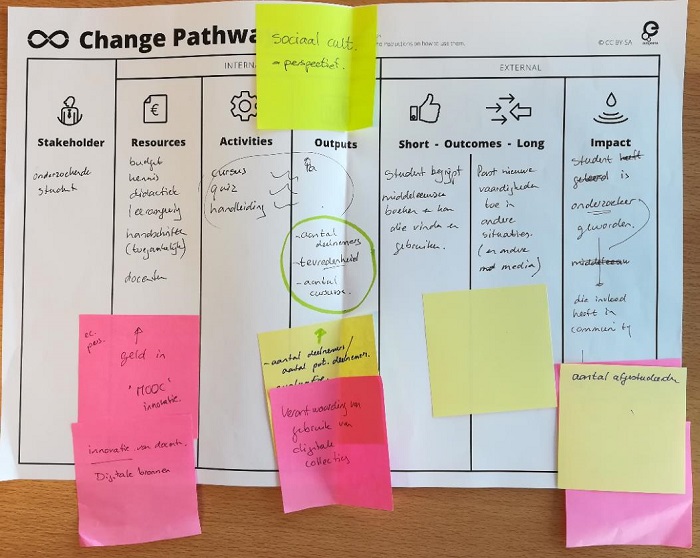Using the Impact Playbook to raise awareness and build confidence with impact
Everybody wants to understand the impact of their work better, but for many the process can seem daunting. In this case study, we hear from Leiden University Libraries’ Marco de Niet on their novel approach to an impact workshop.

- Title:
- Europeana Impact Playbook Change Pathway
- Creator:
- Marco De Niet
- Date:
- 2018
- Institution:
- Leiden University Libraries
- Country:
- Netherlands
- Copyright:
- CC BY-SA
Impact Awareness
This summer, I organised an impact workshop based on the Europeana Impact Playbook at Leiden University Libraries (UBL). As co-chair of the Europeana Impact Taskforce and as a new employee at the library, I was eager to introduce the Playbook to my colleagues there. As some of the terms and concepts of impact assessment can be daunting at first look, we decided that the goal of the workshop should be to let staff members of UBL familiarise themselves with the Europeana Impact Framework and the tools and methods described in the Playbook, in order to get a shared understanding of impact with digital heritage collections. Because we didn’t aim to establish a fully developed impact assessment, the workshop could probably better be qualified as an Impact Awareness Workshop rather than an Impact Assessment Workshop.
We used a UBL project that develops educational tools for students with digitised medieval manuscripts as a case study. Led by Erik Kwakkel and supported through the services of the UBL and social media channels, the digital collection and its tools will also become available to the wider public. This project was chosen as a case study for the workshop because we think the impact of this digital collection on its users could be discussed from various viewpoints.
Twelve colleagues joined the workshop, comprising members of staff from a range of departments and disciplines. Through them, the wide range of user groups of the UBL (academic/non-academic, local/virtual, professional/general interest) could be assessed.
Prior to the workshop, a slide deck was created to control the progress and the timings of the workshop. The slide deck was based on the Europeana Impact Slide Deck. This was augmented with specific information on the Dutch national strategy on digital heritage, the specific user groups of the UBL, the case study and instructions (in Dutch) for the workshop activities in subgroups. The slide deck was used throughout the workshop.
Three out of five tools from the Europeana Playbook were downloaded, printed and used in the workshop: the Empathy Map, the Change Pathway and the Strategic Perspectives. The Pathway Builder and the Value Lenses were not used, due to the nature of the workshop as a one-off impact awareness event.
The Europeana impact tools
In the workshop, we worked with three tools from the Playbook. All three were evaluated positively:
a. The Empathy Map proved to be a good start for the subgroups and the individual participants to put themselves in the shoes of a specific user. In the workshop, two subgroups chose a professional researcher at the university as a stakeholder, one group chose an advanced student and the fourth group a general student. Some groups wrote elaborate notes on the Empathy Map, others mainly used the print-out as a starting point for a discussion on impact on a specific user.

b. The Impact Pathway was the most important tool used in the workshop to better understand the notion of impact and to understand the differences between buzzwords like 'output', 'outcome' and 'impact'. A key factor of success in using the Pathway was to state that the participants needed to start at the right end of the sheet (the impact statement) and work their way back towards the left (ending with describing the resources and activities). All groups were inclined to start from the resources and activities (their daily reality) and then work towards impact assessment. It was an eye opener to start with the notion of the impact you intend to achieve in the long run, instead of taking your current daily activities as the starting point for assessing impact.

c. The Strategic Perspectives were used as a tool to have a fresh look at the Impact Pathway as created by the subgroup. It was not really a surprise that all the subgroups had automatically chosen the Social (socio-cultural) perspective when building the Pathway, as this perspective is closest to the nature of the jobs of the staff members that participated. Bringing in the other perspectives (Economical, Organisational and Innovation) proved to be useful to deepen and expand the discussions on the Pathway.
Setting up an Impact Awareness Workshop: Our learnings
-
While having a case study helped to get a better focus on the academic user groups, in the end the discussions in the subgroups were not very specifically focused on this case. Indeed, it may not be necessary to have such a case study, as it could even limit the discussions.
-
Think very carefully about how you place your subgroups. With 12 participants we decided to do the exercises in small groups of three people. This provided a good opportunity for all participants to be actively involved and not let a single person be too dominant in a subgroup, however some of the groups worked better together than others. If we did this again, we might choose to work in three groups of four instead.
-
Even though our workshop lasted four hours, we did not have enough time reserved for group reflections. Our participants’ feedback suggested they felt this was a missed opportunity.
-
One element of the Impact Pathway caused some confusion. In the example in the Impact slide deck (slide 48), the stakeholder is a History Teacher. But the explanation below the pathway seems to indicate that the true stakeholders are the students of the teacher. If that is the case, then why aren't the students mentioned in the example in the stakeholder box on the left? This confusion about who is the real stakeholder led to a discussion away from the model of the pathway. We gave this feedback to Europeana and they are developing a clearer approach for the next version of the Playbook.
Setting up an Impact Awareness Workshop: Our conclusions
The workshop definitely helped to increase a common understanding at UBL of what impact is about, and the participants felt the Europeana approach to impact could also be useful in contexts other than digital cultural heritage (for example for assessing impact of academic information services). The methodology and tools received positive feedback and the Europeana Slide Deck proved to be a very efficient and comprehensive tool to help prepare and execute the workshop. My goal was to raise awareness and familiarise my colleagues with impact - and this awareness workshop helped us do just that. As an organisation we were not yet ready to dive straight in to a full impact assessment, including impact design and impact narration, as described in the Playbook. So I can strongly recommend that if your colleagues are not yet very familiar with impact assessments a similar awareness workshop is a very good start.
If you are interested in planning and running your own impact workshop, download our Impact Playbook for a step-by-step guide.

